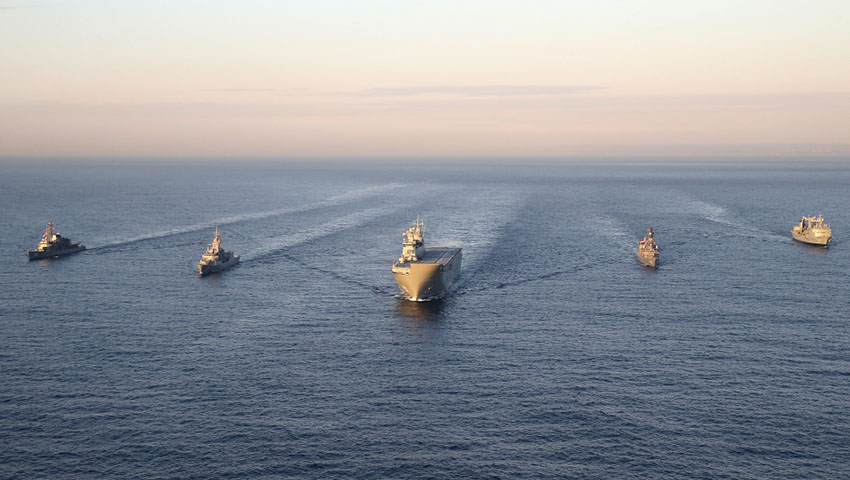As challenges to the modern economic and strategic balance of power in the Indo-Pacific continue to mount, closer collaboration between Australia and Japan will become increasingly important – particularly as peer competition between the US, China and Russia serves to hinder the capability of the US to unilaterally guarantee the regional status-quo.
To continue reading the rest of this article, please log in.
Create free account to get unlimited news articles and more!
China’s continued assertiveness in the South China Sea (SCS) has prompted a resurgence in Japan’s own assertiveness in the region. As an island nation, Japan, like Australia, is dependent on the unrestricted access to strategic sea-lines-of-communication (SLOC) for access to both export markets and strategic resources.
Growing Chinese assertiveness in the SCS and modernisation efforts resulting in the fielding of key power projection capabilities, including aircraft carriers and supporting strike groups, fifth-generation combat aircraft, modernised land forces, area-access denial and strategic nuclear forces, combined with growing political and financial influence throughout the region, is serving to shake Japan's confidence.
However, Japan's geo-strategic realities have rapidly evolved since the end of the Cold War, when the US could effectively guarantee the security of the island nation. Accordingly, the Japanese government has responded with a period of unprecedented defence budgets as the pre-war power seeks to shake off the chains of the pacifist constitution enforced upon it by the US, UK, Australia and other allies following the end of the war in the Pacific.
In response, Japanese Prime Minister Shinzo Abe has repeatedly earmarked increased funding for the nation's defence budget, expanding the capabilities of the Japanese Self-Defense Force (JSDF) to operate independently of direct US support – establishing the nation as an emerging great power with traditional great power style strategic economic, diplomatic and military capabilities.
The Australia-Japan relationship is the nation's closest and most mature in Asia and is underpinned by the strategic, economic, political and legal interests of both countries. The countries work closely in strategic alliance with the US, and lead in critical regional partnerships with countries such as India and the Republic of Korea.
Promoting closer industrial collaboration
Australia and Japan regularly participate in joint defence exercises and frequently consult on regional security issues, such as the nuclear tests and ballistic missile launches undertaken by North Korea. Meanwhile, the Joint Declaration on Security Cooperation (JDSC) signed in 2007 provides a foundation for wide-ranging co-operation on security issues for both countries, including law enforcement, border security, counter terrorism, disarmament and counter-proliferation of weapons of mass destruction.
Enhancing the economic relationship between Australia and Japan is a key component for enhancing the strategic partnership between the two nations – the joint operation of key platforms including the Aegis combat system and F-35 Joint Strike Fighter provide avenues for greater industrial collaboration and research and development between the two nations.
This is identified in the JFY2019 Defense Related Budget Request, which recognises the broad importance of the Australia-Japan relationship, saying, "The Japan-US alliance as well as defence co-operation with India, Australia, ASEAN countries and other partners can work very effectively in maintaining peace and stability of Japan and the region. Japan should develop a defence capability that can further deepen and expand these endeavours."
The budget also focuses on encouraging structural reform of the nation's industrial and research and development (R&D) capabilities as part of building closer collaboration, improved interoperability and distributed lethality.
Australian industry, defence and academia are well positioned to benefit from Japan's arms build-up across a number of areas. Australian involvement in the global F-35 program, as both a key supply chain contributor and as an Asia-Pacific regional maintenance, upgrade and overhaul hub, combined with the growing interoperability of key naval platforms, serves as catalysts for this integration.
Increased military deployments and engagement
While Australia and Japan enjoy a robust and productive military-to-military relationship, the changing regional dynamics necessitate increased regional collaboration and integration – this is especially critical given the mutual dependence on unrestricted access to SLOCs and the ocean more broadly.
Increasing joint Australian-Japanese military-to-military participation and interoperability is an important part of supporting the development of load sharing in the region. This could include increased forward basing of Australian military assets including Collins Class submarines, Hobart Class destroyers, Anzac Class frigates, P-8A Poseidons and F-35s to Japanese facilities.
Further enhancing these capabilities is the integration of Japan's planned Aegis ashore sites with Australia's world-leading JORN network, the expected AIR 6500 integrated air and missile defence program and the various layers of Australia's expected air and missile defence systems across the Army, Navy and Air Force.
Incorporating these capabilities, combined with enhanced interoperability as a result of operating similar or in some cases the same platforms, enhances the development of a theatre-based integrated air and missile defence system supporting the defence of key air, land, sea and space-based assets of Japan, Australia and, more broadly, US military assets based in the region.
For both Australia and Japan, nations defined by their relationship with traditionally larger, yet economically weaker regional neighbours, the growing economic prosperity of the region and corresponding arms build up, combined with ancient and more recent enmities, competing geo-political, economic and strategic interests, places the nations at the centre of the 21st century's 'great game'.
Further compounding the precarious position of the two US-allies is the need to accept that 'Pax Americana', or the post-Second World War 'American Peace', is over and Australia and Japan will be required to develop both unique national responses to defend their unique national interests, with a focus on supporting the key alliances.
Get involved with the discussion and let us know your thoughts on Australia's future role and position in the Indo-Pacific and what you would like to see from Australia's political leaders in terms of partisan and bipartisan agenda setting in the comments section below, or get in touch with

 Login
Login







